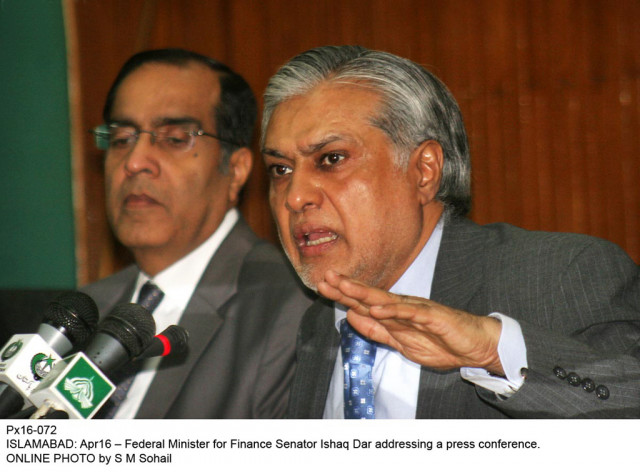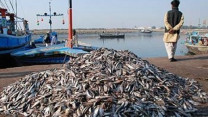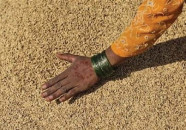Under performance: Economic growth weakens to 3.2% in second quarter
Govt does not release quarterly data, presents average growth for first half.

Finance Minister Ishaq Dar addressing a press conference in Islamabad on April 16, 2014. PHOTO: ONLINE
As the country’s external financial woes have started easing following a $2-billion Eurobond issue, the domestic economic conditions still remain fragile with growth dropping to 3.2% in the second quarter of the current fiscal year, dashing hopes of an early recovery.
Instead of announcing the second quarter growth, which remained slower than expected, the government on Wednesday presented average growth rate for the first six months, which is contrary to international standards.
In the first half (July-December) of the current fiscal year, the average growth stood at 4.1%, said Finance Minister Ishaq Dar while addressing his first press conference after returning from the United States.
He did not share the second quarter (October-December) data. In the first quarter, the economy grew at a rate of 5%, according to government’s data.
An official of the Pakistan Bureau of Statistics (PBS) said the second quarter growth was 3.2%.
Holding back the quarterly data is against the international standards that the government has agreed with the International Monetary Fund aimed at ensuring transparency.
“The average 4.1% growth is useless until a technical committee comprising experts certifies the number,” said Dr Ashfaque Hasan Khan, a leading economist and an expert in national accounts.
Dar said in the first half the agriculture sector grew 2%, industrial sector rose 5.4% and services sector expanded 4.4%.
He said Pakistan had received $2 billion on account of Eurobonds floated last week. With the fresh external borrowing, the foreign currency reserves have increased to the level from where they had started coming down over a year ago.
The reserves held by the State Bank of Pakistan increased to $6.9 billion and total reserves including those held by commercial banks were at $11.67 billion, Dar said.
Responding to critics of his policies, he said the fresh borrowing would not increase total debt of the country as the government would retire domestic debt by the same amount.
Terming the criticism against the high cost of borrowing unjustified, Dar said despite paying interest rates in the range of 7.25% to 8.25%, the bond-backed borrowing was still cheaper than domestic debt.
The government would save $90 million per annum on this account, he claimed. However, the claim will be true as long as the rupee-dollar parity remains at the current level for the next 10 years.
The day the rupee will start depreciating the cost of bond servicing will automatically increase, according to analysts.
Pakistan’s bond was oversubscribed by 14 times with total offers of $6.9 billion, of which $3.9 billion were for five-year and $3 billion for 10-year papers, he added.
Dar announced that the US had promised to release $380 million this month out of the outstanding $1.5 billion on account of the Coalition Support Fund. Apart from this, the World Bank will approve $1 billion in programme loans for energy and taxation areas on May 1.
The Asian Development Bank is also expected to approve $400 million for the energy sector in the last week of current month.
In the next four years, the WB has agreed to give $11 billion to Pakistan under the 2015-19 Country Partnership Strategy. According to Dar, the WB-funded projects will only be initiated in four priority areas, set by the government.
In the last week of May, the WB will approve $600 million for Dasu Dam while the remaining $3.2 billion required to complete first phase of the project, will be provided by the bank in the next three years.
Dar said the WB had also agreed to arrange an international investment conference in New York to help Pakistan raise funds for Diamer Bhasha Dam.
Published in The Express Tribune, April 17th, 2014.
Like Business on Facebook, follow @TribuneBiz on Twitter to stay informed and join in the conversation.



















COMMENTS
Comments are moderated and generally will be posted if they are on-topic and not abusive.
For more information, please see our Comments FAQ